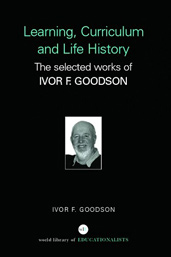Learning, Curriculum and Life Politics: the selected works of Ivor F. Goodson
On Curriculum Form
Wrottesley gave an example that confirmed his worst fears:
... a poor boy hobbled forth to give a reply; he was lame and humpbacked, and his wan emaciated face told only too clearly the tale of poverty and its consequences ... but he gave forthwith so lucid and intelligent a reply to the question put to him that there arose a feeling of admiration for the child's talents combined with a sense of shame that more information should be found in some of the lowest of our lower classes on matters of general interest than in those far above them in the world by station.
He concluded:
It would be an unwholesome and vicious state of society in which those who are comparatively unblessed with nature's gifts should be generally superior in intellectual attainments to those above them in station (quote in Hodson 1987, pp. 36 – 37).
Soon after Wrottesley's comments in 1860, science was removed from the elementary curriculum. When it eventually reappeared in the curriculum of the elementary schools some 20 years later, it was in a very different form from the science of common things. A watered-down version of pure laboratory science had become accepted as the correct view of science, a view that has persisted, largely unchallenged, to the present day. Science, as a school subject, was powerfully redefined to become similar in form to so much else in the secondary curriculum - pure, abstract, a body of knowledge enshrined in syllabuses and textbooks (Goodson 1988).
The fundamental insight is that even with a subject conceived of as a challenge to the traditional academic curriculum incorporation can take place. Hence, science, which was thought of a practical and pedagogical, ended up as ‘pure laboratory science’.
Continuities and Complexities
The early 19th Century pattern of differing ‘mentalities’ and differing curricula that Shapin and Barnes noted has had considerable durability. Of course, the continuities that can be discerned must be fully related to the complexity of each historical period. In this sense, I am only pointing to an agenda for future historical work.
The apparent continuities are sufficiently clear, however, as to warrant substantial further historical study. For instance, almost a century later, the Norwood Report of 1943 advocated the notion of different mentalities and of different curricula and, indeed, different schools to serve these mentalities. This report led, in Britain, to the 1944 Education Act, which may be seen as institutionalising a social and political order for schooling, built upon a hierarchy of mentalities.
